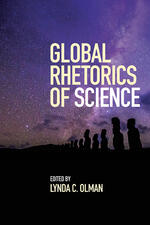
Global Rhetorics of Science
Guest post by Lynda C. Olman
"We can’t solve our problems with the same kind of thinking that created them." Attributed (probably wrongly) to Einstein, this quip nevertheless perfectly expresses the inspiration behind Global Rhetorics of Science, our new book with SUNY Studies in Technical Communication. The rhetoric of science (ROS) has made great strides in recent years in diversity, considering rhetorics of disability, gender, race, and posthumanism. But the field has so far failed to diversify the idea of science itself, which is unfailingly defined according to the dominant Euro-American paradigm. If they read only in ROS, readers would likely never learn that other scientific systems (or natural philosophies) existed in the world. Meanwhile, fields like history, philosophy, and sociology have known about other, older global sciences for nearly 200 years and written seriously about them. The authors in our book believe that in an era when Euro-American science has materially participated in creating crises around climate change, genetic manipulation, and surveillance and privacy (to name just a few areas), it seems high time to bring more global sciences on board to diversify our toolkit for dealing with global risk.
What can the field of rhetoric add to the conversation? It turns out that the very process by which Euro-American science became the dominant global science is itself a rhetorical process—specifically, a process of synecdoche by which a part of something comes to stand in place for the whole. The first chapter of our volume, by Kelly Happe and me, details the history of how this happened. The rest of the volume seeks to do what rhetoric does best—invent new ways of talking about the relationship between science and society. Taking the trope of synecdoche as a guide, we explored the other “master” tropes, delighting in turning them against themselves in decolonial projects: irony, metaphor, and metonymy. Here are a few quotes from those chapters that will hopefully entice you to read more from these authors working within diverse global scientific and rhetorical traditions:
Irony is the trope that exposes contradictions in things that were thought to be similar. In this volume, we use the trope to show how Euro-American science is subverted or resisted in colonial and neo-colonial encounters around the world:
In their chapter on Australian Aboriginal ecology, Emilie Ens and her co-authors write, "This chapter takes an ironic approach to global rhetorics of science by revealing the injustices that have resulted from the colonial imposition of Euro-American science in Indigenous communities alongside the ways in which Indigenous rhetorics of science have resisted colonization by Euro-American science. In short, our case study shows that Euro-American science, when practiced in contemporary Australia in collaboration with Indigenous communities, is actually becoming a hybrid of Euro-American and Indigenous practices" (p. 46).
In their chapter on Nigerian medicine, Toluwani Oloke and Olusegun Soetan write, "This study helps illustrate the claim that there are certain paradigms of health systems in the African belief systems that, despite the advent and development of Euro-American medical practices and medicines, have stood the test of time. We also argue that health communication campaigns that focus on the inefficacies of African scientific and medical methods communicate a fundamental disrespect of African epistemologies that ironically (a) obscures evidence and counter-claims supporting the efficacies of traditional African healing methods and scientific thoughts while (b) dissuading some Africans from accepting Euro-American treatments" (p. 63).
In their chapter on Chinese public health communication, Huiling Ding and Jianfen Chen write, "Our study reveals that this bottom-up movement to reshape China’s air policy was ironically, though unintentionally, started by a foreign player, the U.S. embassy in Beijing (referred to as the U.S. embassy in the rest of the chapter for the sake of brevity). Transmedia such as the cell phone app BeijingAir mediated the risk conception from the Euro-American actor to Chinese actors in this air-policy-change event. However, the successful civic engagement in risk communication of PM 2.5 and the ensuing air policy change came from the Chinese publics’ association of the risk of PM 2.5 with health when the government downplayed the accountability related to it” (p. 88).
Metaphor is the process of revealing similarities between two things thought to be very different. In our volume we use global sciences as prompts to invent new, innovative ways of thinking and talking about global risks.
For instance, in his chapter on Polynesian archeoastronomy, Franciso Nahoe writes of the famous moai of Rapa Nui, which grace the cover of our book, "Without the resources of rhetorical analysis, carving moai and sailing upon the ocean appear before us as essentially dissimilar activities utterly divorced from one another. This chapter has seen fit to efface that distinction by asking how visual metaphor on Rapa Nui exploits the science of sidereal navigation to construct a social cosmology capable of sustaining itself under harsh conditions" (p. 131).
About Celtic knots, which have recently attracted the attention of complexity mathematicians, Evelyn DSouza writes, “Rhetoricians of science have taken a keen interest in the use of visual representation in meaning-making—for example, the graphical depiction of the littoral zone in a geological memoir[i] or circulations of the famous “hockey stick” graph in climate change discourse[ii]—and this essay dually examines Celtic geometric art (nonlinguistic, non-discursive rhetorical figures of knots, spirals, and symmetric patterns) as a powerful visual rhetoric and rhetoric of science. This chapter aims to contribute to global rhetorics of science using the trope of metaphor, showing how an ancient visual practice can help us make and interpret arguments in an emergent age of complexity science by shaping and reshaping our thinking” (p. 140).
Finally, metonymy is the trope of treating a subject via a symbol or emblem of it. In our volume we use the trope to consider how alternative non-reductive stories might be told about natural phenomena, rather than classical scientific narratives that reduce these phenomena to their causes.
For example, in their chapter on Navajo (Diné) and Zuni health communication during the COVID-19 crisis, Sunnie Clahchischiligi and her co-authors write, "Since sovereign indigenous communities are unique, we cannot generalize the experience described here to all indigenous communities. Yet, what it reveals, something especially relevant in the broader context of the Global Rhetorics of Science volume, is that communities, when faced with crises of community health and wellbeing, often generate their own health communication strategies, which are not derivative of the otherwise dominant, often governmental, discourses. Here, we see indigenous communities developing practices that do not emulate Western tropes, but where indigenous narratives are the ur-text" (p. 160).
And in his chapter on the long and diverse history of native Icelandic glaciology, Ryan Eichberger writes, "Iceland’s glaciers exist in a web of microclimates and seabirds, herbaceous flora and human love and grief. They can be known partly by institutional science, but localist practices like hillwalking, mountaineering, farming, and shepherding have generated their own glacier knowledge. Glaciers, and knowledge of them, might best be thought of as metonymic—existing in irreducible entanglement with ecology and, respectively, with other knowledge systems" (p. 181).
It’s our hope that, just as we were inspired by the incredible richness of the joint world-building and community-building practices that we’ve called Global Rhetorics of Science, our readers will also be inspired—to find new ways of working across assumed boundaries not to just survive, but to thrive in an era of global risk.
Lynda C. Olman is Professor of English at the University of Nevada, Reno. She is the author of Sins against Science: The Scientific Media Hoaxes of Poe, Twain, and Others, also published by SUNY Press.
Photo of Ahu Toŋariki at Dawn by Beatriz del Carmen Rapu Tepano
****
[i] Alan G. Gross, “Toward a Theory of Verbal-Visual Interaction: The Example of Lavoisier,” Rhetoric Society Quarterly 39, no. 2 (2009): 147–69.
[ii] Lynda Walsh, “The Visual Rhetoric of Climate Change,” WIREs Climate Change 6, no. 4 (2015): 361–68, https://doi.org/10.1002/wcc.342.


